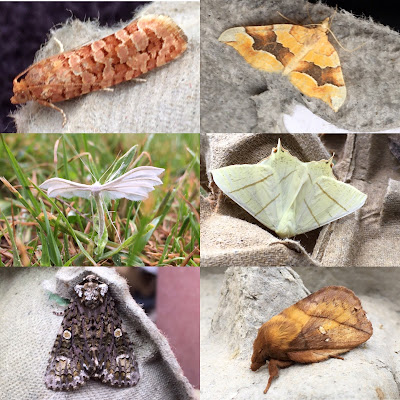 Midsummer is a wonderful time for moths. Small wonder that Shakespeare gave the name 'Moth' to one of Titania's fairy band (painted by Arthur Rackham, left). This year they - the moths, though maybe the fairies too - were out in strength on all three of the shortest nights whose sunset-to-sunrise lasted just under seven hours from 9.48pm to 4.46pm. Given the glow which stays in the sky for over an hour afterwards, often much longer, the moths have very long days in which to have a good sleep.
Midsummer is a wonderful time for moths. Small wonder that Shakespeare gave the name 'Moth' to one of Titania's fairy band (painted by Arthur Rackham, left). This year they - the moths, though maybe the fairies too - were out in strength on all three of the shortest nights whose sunset-to-sunrise lasted just under seven hours from 9.48pm to 4.46pm. Given the glow which stays in the sky for over an hour afterwards, often much longer, the moths have very long days in which to have a good sleep.Here is a pot pourri of some of my visitors on the night of 20th June, headed in the top left-hand corner by one of the prettiest micros to visit me regularly: Lozotaeniodes formosana. Goodness what a cumbersome name! Proceeding clockwise, we then have a bright Barred Yellow, a Swallowtail - the ghost-like moth often caught in car headlamps or at kitchen windows in the Summer, a Drinker, fascinating creature of which more anon, a Coronet with its gloriously subtle shades of olive and mauve and a White Plume, or as one of my nieces calls it, the Spirit Moth. She speaks wisely. The Greek word 'psyche' was used in ancient times to mean both 'butterfly' and the human soul.
The Coronet in particular repays a closer look, so here are some more pictures of the three which came to the trap that night. They also serve to show the light-based vagaries of digital photography, although these were different moths. A camera cannot lie, but it may mislead, which is one of the reasons why my ID efforts so often misfire.
My third compilation gives an even more striking example, because all three pictures are of the same moth, taken from different angles. I had a bit of a struggle sorting it out as a result but the top photo tallied exactly with the painting of a female Dark Umber by the amazingly skilful Richard Lewington in the Moth Bible. This is a moth which is classified as only locally common, but it faithfully comes to see more every year. Midsummer's Eve was its debut in 2020.
The night also saw the arrival of my second Riband Wave of the year, shown here below one of my favourite regulars, a Bloodvein. The Riband comes in two forms, one with the eponymous ribbon a darker shade than the rest of the wings and this version where the band is distinguished only by its edge lines.
The following night was equally rich in numbers and here is a selection. Clockwise from the top left, please meet a Clouded Border, a Burnished Brass form juncta (with the darker patches separated by a strip of sheen), a Barred Fruit-tree Tortrix micro, aka Pandemis cerasana, a Privet Hawk, the UK's third-largest moth which delighted some passing neighbours, a Beautiful Hook-tip about which I have rhapsodised previously, and a Common but uncommonly lovely Emerald.
Finally, Midsummer Day also dawned in the eggboxes on this tiny spider with its huge egg sack. I await identification from iRecord. Alas, the days get gradually shorter now but who cares when the weather is so idyllic?







2 comments:
A really great haul Martin-so exciting to get some real corkers there! Love those Drinker Moths on the later post. Though I have seen them, I see the larvae far more often.
Me too - I used to enjoy looking after them. Yes, it's a terrific time of the year - I just wish there was more time to do everything justice. The glowworms in my later post were really exciting to find too, right on our doorstep. Worth looking round you maybe. All warmest M
Post a Comment